European pet care: fast and slow

With 5 of the top 10 markets in the world, European pet care is characterised by disparities. Accounting for nearly a third of global sales, Eastern and Western Europe are quite different regions, with quite different outlooks.
Western Europe
Western Europe accounts for 26% of global pet care sales, with the UK, Germany and France its largest markets. It was one of the less dynamic regions over the 2012-2017 period right above Australasia which was the least dynamic in terms of growth. Nevertheless, many consumers enjoy good disposable income, and sales of premium dog and cat food are the most dynamic, with growth rates reaching 25% in France over 2012-17.
Treats was the most dynamic category across all Western European markets driven by a myriad of innovation: from functional treats addressing key concerns such as oral care, to pure indulgence treats, which saw many launches. This was reflected in cat treats achieving 51% growth and dog treats 28%.
With Spain and Italy as the best performing countries over the 2012-2017 period, higher pet
care gains came from Germany and the UK, with gains in excess of €400 ($492) million and €350 ($431) million, respectively. At the other end of the spectrum, Greece faces a decline as the economic circumstances are still quite challenging. In fact, economic prospects in Greece remain pessimistic and disposable incomes are anticipated to decrease further as consecutive austerity measures take their toll on consumer purchasing power. Forecasts for pet care products are not optimistic.
Eastern Europe
The third fastest growing region, Eastern Europe, sees strong disparities amongst its markets with Russia clearly standing out as the largest market in the region, and the only market in the top 10.
However, smaller markets such as Poland and Czech Republic have also posted strong growth and offer good potential, even if Bulgaria was the fastest growing market over the 2012-2017 period. The potential is also high when looking at the pet population: Romania, Hungary and Russia rank among the highest in terms of percentage of households owning cats.
Unlike its western counterpart, in Eastern Europe sales of economy dog and cat food are still quite relevant, with premium accounting for a mere 20% of dog and cat food in the region in 2017. Russia stands out as the largest market in the region with economy and mid-priced segments leading.
Many consumers are still entering commercially prepared food for the first time, hence the importance of the economy segment. In Eastern Europe overall, there is still plenty of space for growth and to increase the penetration of prepared food.
Premiumisation is quite important and the driver behind many launches and innovations. But this is still more prevalent in more developed markets such as Russia, with gains in excess of €107 ($132) million over 2012-17.
What does the future hold?
Overall, a growing interest in health and wellness is expected to drive growth in both regions, particularly as high-income consumers look to feed their pets better, paying more attention to natural, organic and sustainable ingredients.
Western Europe is expected to remain quite steady as uncertainty still looms in many markets and it is also expected in some specific categories – dog and cat treats offer some of the best opportunities.
In Eastern Europe – with Russia’s recovery underway and other markets following suit – the region is expected to post double digit growth for the next
5 years, the fourth fastest growing region.
Local manufacturers are expected to become more competitive and gain a stronger edge over multinationals. This is also expected to reflect in the markets’ growth as competition stiffens and drives innovation.
